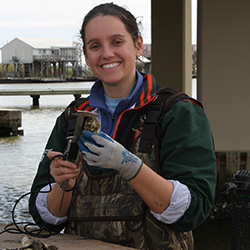
SARAH BODENSTEIN - SCHOOL OF RENEWABLE NATURAL RESOURCES
Project Summary
Oyster aquaculture is an integral part of the economy and culture of Louisiana. However, many growers in the region are experiencing oyster mortality events, especially in the summer months. While the exact causes of these events remain unclear, selective breeding programs my offer a solution to the problem of high oyster mortality. However, genetic improvement can prove difficult without the use of tools such as cryopreservation repositories. Repositories have long been used in the beef cattle industry to easily provide breeders with genetic material from all over the country to facilitate rapid genetic improvement. Unfortunately, as of yet, no such cryopreservation and repository systems exist for aquatic species. While high-throughput cryopreservation protocols exist for oysters, protocols alone are not sufficient to foster repository development. To address this issue, this study used time study analysis and simulation modeling to standardize and integrate a high-throughput cryopreservation protocol into a repository development pathway. Nine cryopreservation trials were performed during which each step in the cryopreservation protocol was timed. Time distributions for each step were generated based on time study data. Distributions were then included in a simulation model. Therefore, the model reflected real-world working conditions and could be used to simulate outputs, such as the number of oysters processed (throughput) or cost, in a given about of time based on certain conditions. Conditions included factors such as the number of French straws (the freezing container) frozen per oyster or the number of operators available. Results highlight how altering the number of straws per oyster greatly affects outputs and can be used to inform protocol standards and facilitate cryopreservation and repository integration into oyster aquaculture.